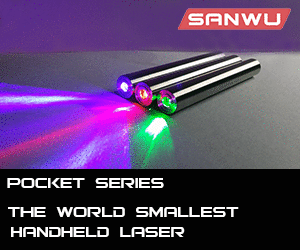Okay, I have seen alot of posts around here with people going "I got a new laser, but it looks like the same brightness as my lower power one, whats wrong?"
Well, the answer is this. Putting aside your laser MAY be underpowered, lets just assume they are correct in thier ratings for now.
Our eye's sensitivity to brightness IS NOT linear! Meaning, after you get to a certain power, it takes ALOT more power to achieve a brighter laser!
For example, My scanner originally used a 40mw green. Now I thought this was getting kinda dull, so I went out and bought a 100mw CNI module, doing about 141mw. Its 3 times the power, so 3 times the brightness? WRONG!
Actually, there was only a tiny difference in brightness between the 2 lasers! After the CNI had a warm up, you culd slightly see a difference, but deffinately not what I was expecting. This is due to your eye's brightness sensitivity not being linear!
Some people try pot mod thier lasers, and yes you may get about more power out, but unless you pot mod it to the max, the brightness isnt gonna be as good as you expect, up to a point. Sure, if you pot mod a 5mw, then you will see a difference, but do it to a 100mw, and it will take ALOT of modding to acheive anything brighter.
Think of this as a rule of thumb: To get 2X the brightness, you need about 4X the power!
As I said, this is up to a point. Below 30mw, you should be able to notice the difference, but go too high above that, and it takes ALOT more power. Hope this helped anyone wondering !
EDIT: Yay 3000 posts, and a member for 500 days!
/me parties with lasers
Well, the answer is this. Putting aside your laser MAY be underpowered, lets just assume they are correct in thier ratings for now.
Our eye's sensitivity to brightness IS NOT linear! Meaning, after you get to a certain power, it takes ALOT more power to achieve a brighter laser!
For example, My scanner originally used a 40mw green. Now I thought this was getting kinda dull, so I went out and bought a 100mw CNI module, doing about 141mw. Its 3 times the power, so 3 times the brightness? WRONG!
Actually, there was only a tiny difference in brightness between the 2 lasers! After the CNI had a warm up, you culd slightly see a difference, but deffinately not what I was expecting. This is due to your eye's brightness sensitivity not being linear!
Some people try pot mod thier lasers, and yes you may get about more power out, but unless you pot mod it to the max, the brightness isnt gonna be as good as you expect, up to a point. Sure, if you pot mod a 5mw, then you will see a difference, but do it to a 100mw, and it will take ALOT of modding to acheive anything brighter.
Think of this as a rule of thumb: To get 2X the brightness, you need about 4X the power!
As I said, this is up to a point. Below 30mw, you should be able to notice the difference, but go too high above that, and it takes ALOT more power. Hope this helped anyone wondering !
EDIT: Yay 3000 posts, and a member for 500 days!
/me parties with lasers



